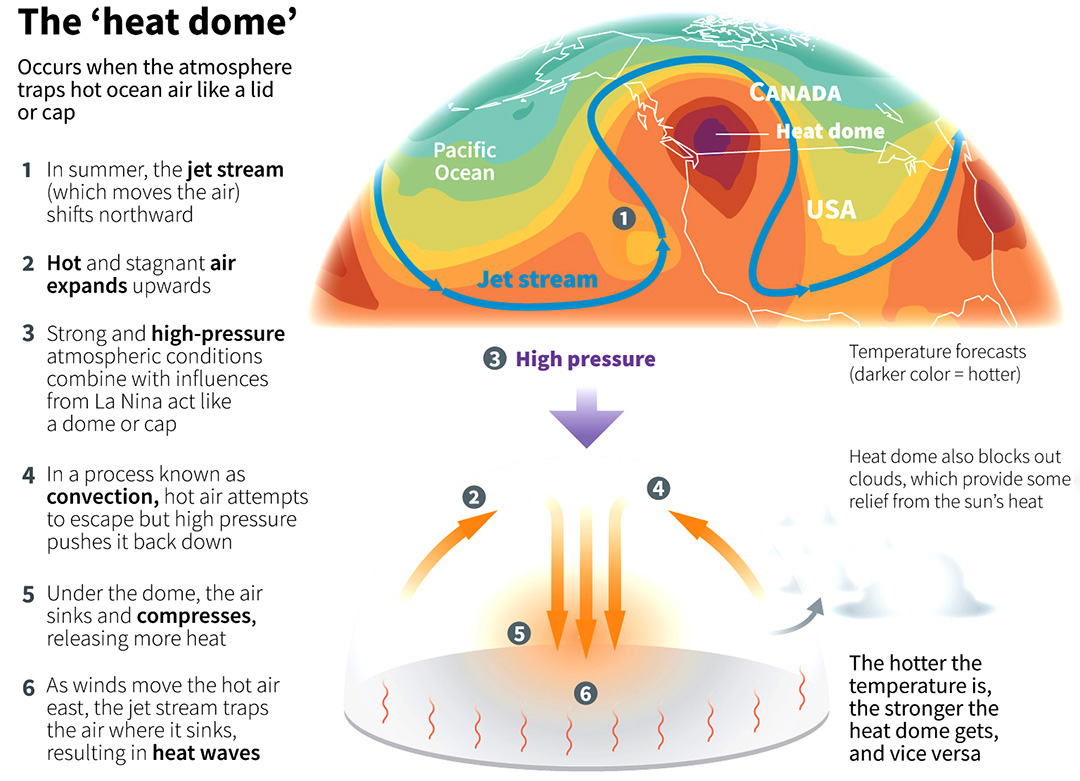Heat Dome | 02 Jul 2021
Why in News
Recently, the Pacific Northwest and some parts of Canada recorded temperatures around 47 degrees, causing a "historic" heat wave.
- This is a result of a phenomenon referred to as a "heat dome".
Key Points
- About:
- The phenomenon begins when there is a strong change (or gradient) in ocean temperatures. In the process known as convection, the gradient causes more warm air, heated by the ocean surface, to rise over the ocean surface.
- As prevailing winds move the hot air east, the northern shifts of the jet stream trap the air and move it toward land, where it sinks, resulting in heat waves.
- Jet streams are relatively narrow bands of strong wind in the upper levels of the atmosphere. The winds blow from west to east in jet streams but the flow often shifts to the north and south.
- This strong change in ocean temperature from the west to the east is the reason for the heat dome (HD).
- The western Pacific ocean’s temperatures have increased in the past few decades and are relatively more than the temperature in the eastern Pacific.
- HD also prevents clouds from forming, allowing for more radiation from the sun to hit the ground.
- A heat dome is effectively what it sounds like - an area of high pressure that parks over a region like a lid on a pot, trapping heat. They are more likely to form during La Niña years like 2021, when waters are cool in the eastern Pacific and warm in the western Pacific.
- Heat Wave:
- A heat wave is a period of abnormally high temperatures, more than the normal maximum temperature that lasts for more than two days.
- Heat waves typically occur between March and June, and in some rare cases even extend till July.
- Heat waves can occur with or without high humidity and have the potential to cover a large area, “exposing a high number of people to hazardous heat.”
- Impact on Humans (Wet-bulb temperature):
- As long as the body is producing sweat, which is then able to evaporate quickly, the body will be able to remain cool even under high temperatures.
- Wet-bulb temperature (WBT) is a limit that considers heat and humidity beyond which humans can not tolerate high temperatures.
- Temperatures beyond WBT can cause heat related illnesses including heat stroke, heat exhaustion, sunburn and heat rashes. Sometimes these can prove fatal.
- Effects of Heat Dome:
- Those living without an air conditioner see the temperatures of their homes rising to unbearably high, leading to sudden fatalities.
- The trapping of heat can also damage crops, dry out vegetation and result in droughts.
- The sweltering heat wave will also lead to rise in energy demand, especially electricity, leading to pushing up rates.
- The heat domes can also act as fuel to wildfires, which destroys a lot of land area in the US every year.
- Climate change and heat domes:
- The weather scientists have been highlighting the effects of climate change on more extreme heat waves.
- According to a 2017 NOAA (National Oceanic and Atmospheric Administration) survey, average US temperatures have increased since the late 19th century.
- However, Scientists are usually wary of linking climate change to any contemporary event mainly because of the difficulty in completely ruling out the possibility of the event having been caused by some other reason, or being a result of natural variability.
- The weather scientists have been highlighting the effects of climate change on more extreme heat waves.

